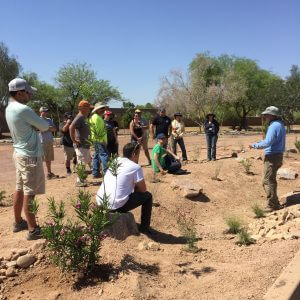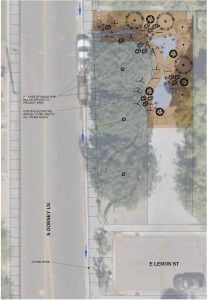Harold Thomas
Tucson, Arizona
Harold joined Watershed Management Group (WMG) in 2019. He has two graduate degrees, one in Urban and Environmental Planning, and another in Sustainable Development. Harold has supported community-led projects in the US, Mexico, Ecuador, and Thailand, specializing in the integration of water resources management and land use planning, Indigenous planning, and using exploratory scenario planning for sustainable and adaptive solutions. When not working, he likes to travel to distant places, hike, raft, do yoga, and eat.
This interview was conducted by Carly Schmidt on September 18, 2019. Learn more about Harold’s work at the Watershed Management Group.
Tell me about WMG and your role in the organization.
WMG is a nonprofit based in Tucson, Arizona and we are focused on getting the seven desert rivers in Tucson flowing again. There is this long history of groundwater overuse in this region with water being pumped for agricultural and municipal use, which had a number of impacts. One impact was the loss of one of the largest mesquite bosques in the world. What WMG does is work with homeowners, schools, businesses, governments, and other partners to look at what people can do on different scales to get our watershed restored and rivers flowing again.
I am the assistant director at WMG and I direct our Green Living Co-op program, which teaches practical skills by helping implement projects at members’ homes. We’re really looking at how, through earthworks, people can do restoration at home and be connected to larger-scale watershed planning. This effort is a part of our 50 year vision and watershed plan to get our rivers flowing again. What we’ve found is that working on different scales can make this work really effective.
You have an ongoing partnership with Four Peaks Brewery and River Network to host annual events. Tell me about how these events got started.

Volunteers from Four Peaks at the event site in 2018.
All of our work is collaborative. We are working with Anheuser-Busch, Four Peaks Brewery, Arizona Department for Forestry and Fire Management, and the U.S. Forest Service to bring people together to install green infrastructure features at a small neighborhood park. The site is not well-used at the moment. It is mostly hardscapes like cement and gravel. By working with River Network and Four Peaks, which is owned by Anheuser-Busch, we have identified a site with the City of Tempe that is close enough to the brewery to get some volunteer turnout. We did a similar project with the same partners last year, and we are currently planning two work days with the same partners in October.
How were partners initially engaged in this project?
This is a follow-up project to work we had done with River Network in the past. We were doing some work in Phoenix and River Network reached out to WMG asking if there was interest in working with Anheuser-Busch and Four Peaks because we were doing a volunteer day at the time. That’s what really got this ball rolling.
What kind of restoration work will volunteers be doing at this upcoming event?

Demolition, stormwater inlet, sediment trap and planting plan at the Dorsey & Lemon Park Green Infrastructure demonstration site.
First there’s a demolition plan. We’re excavating some of the rock and soil so we can create some basins. We are also taking out grasses that are water intensive. The second phase is creating a stormwater inlet to let street water be captured onsite. The third phase is planting. We’re going to keep some low water users that are already there, like large trees, and add a whole bunch of native plants that will grow without irrigation.
Projects like this are so important because, if done well, the site can demonstrate that this kind of restoration is possible. There’s a widespread mentality in these desert cities that you need a lot of water and irrigation to create and sustain a beautiful landscape. What these projects show is that you can have a beautiful lawn or park with rainwater harvesting. This work is also important because some of these features, like rainwater harvesting, are new to policy guidelines around how water can be harvested from streets. We can show other cities in the valley that guidelines for green infrastructure put in place by Maricopa Association of Governments are applicable across the region. Of course, the aspect of bringing people together can’t be overlooked in these projects. People can connect with their watershed by physically creating these spaces. We just had a brown bag presentation with Four Peaks educating them about what we’re about to do and showing them their work from last year. It’s such a powerful message to show them what they created a year ago if they haven’t been back to the site.
If another organization was looking to initiate a corporate or local business relationship to support a similar events, how would you recommend that they get started?
WMG is going on 15 years of service to our community, so for an organization like us, the way we work and what we do comes directly from the communities we serve. What I would suggest to a local organization trying to initiate some local partnerships is to let the community guide the vision and think big! In the face of climate change, people think that river restoration in Tucson is impossible but we’re doing it! Have a community vision and give your partners, whether it be Anheuser-Busch or the city or whoever, a chance to participate. At WMG we seek participation from a wide audience. If you give people a chance to do something good, they will show up. And, of course, don’t forget to communicate back to the community that is supporting you! Show them the results and impact of their work or support. This has a huge hand in creating buy-in and trust that really makes these projects happen.







